It's the fifth day of Singapore's lockdown "Circuit Breaker", and if cabin fever hasn’t yet gotten the better of you, you might be wondering how we ended up here — not being able to leave our houses.
It does feel like a long time ago, but it was in fact just last month that the co-chair of the Multi-Ministry Taskforce for Covid-19, Lawrence Wong, said rather emphatically that Singapore will not be locked down because there is "no such magic solution as (a) two-week lockdown and then we are free from the virus."
"It will not happen," he said.
So now, as we're cooped up at home (or wherever we might be holed up in for this period), it begs the question: how did we?
We trace the events of the past two months as they unfolded, starting with —
Feb. 7: DORSCON Orange
On Feb. 7, Singapore moved its Disease Outbreak Response System Condition (DORSCON) risk assessment to Orange.
By then, Singapore had 30 confirmed cases of Covid-19, with just one pesky unlinked case — number 29 — not traceable to previous cases or travel history to China. In other words, there was community spread.
Moving the risk assessment to Orange was significant. There would be moderate disruptions to daily life, including measures such as quarantine, temperature screenings, and visitor restrictions at hospitals.
The last time we reached DORSCON Orange was during the 2009 H1N1 pandemic. But back then, after a mere 11 days, the authorities downgraded the risk assessment back to Yellow on May 11, 2009.
For comparison, this time, we have already been at Orange for more than two months (and counting!).
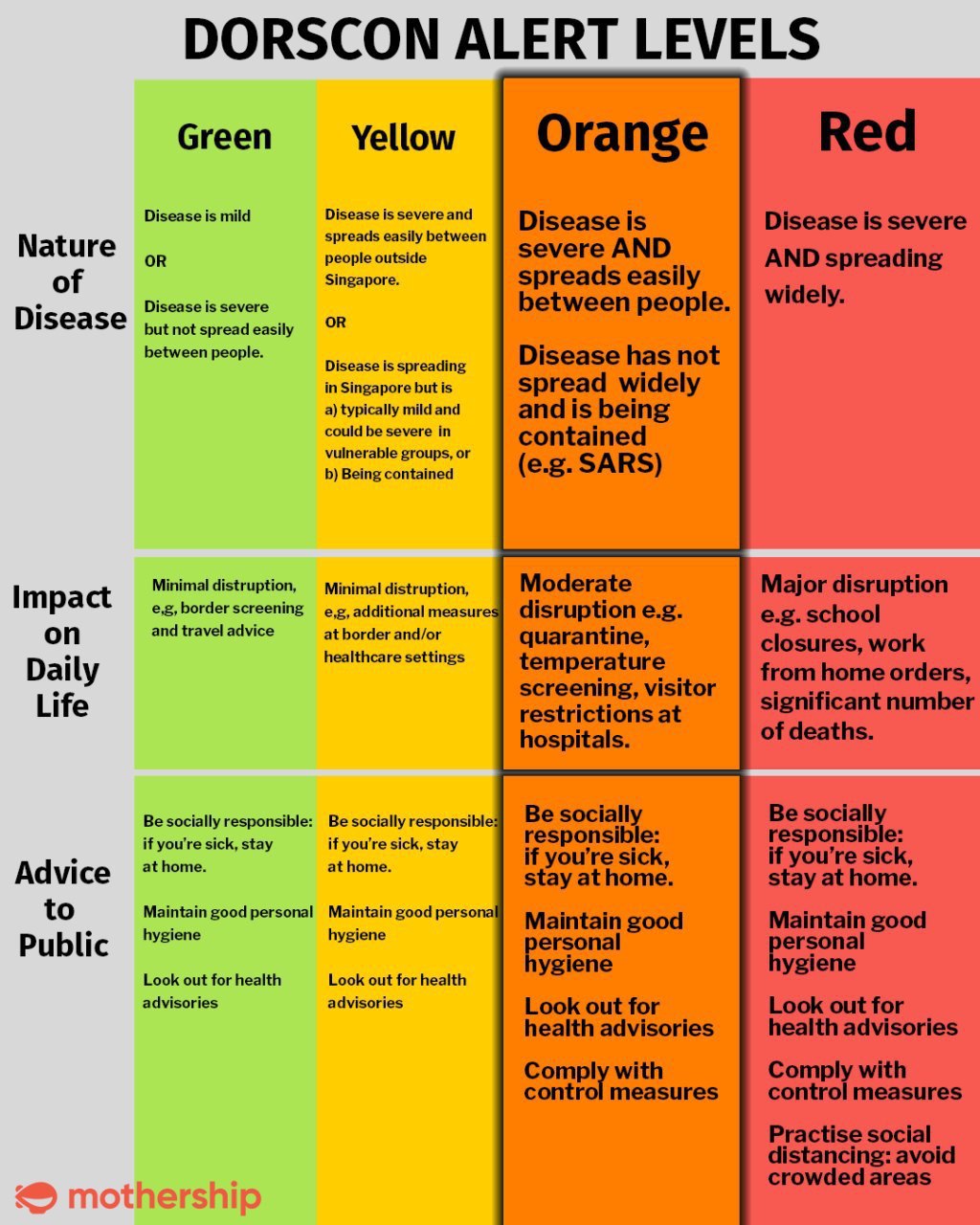
On Feb. 8, Prime Minister Lee Hsien Loong addressed the nation.
"We are not locking down the city or confining everybody to stay at home," he declared, assuring people that there was no need to panic-buy groceries or hoard food. Or toilet paper.
PM Lee did caution, however, of the need for the government to reconsider its strategies if the number of infections was to keep rising.
"If the virus is widespread, it is futile to try to trace every contact. If we still hospitalise and isolate every suspect case, our hospitals will be overwhelmed. At that point, provided that the fatality rate stays low like flu, we should shift our approach. Encourage those who only have mild symptoms to see their family GP, and rest at home instead of going to the hospital, and let hospitals and healthcare workers focus on the most vulnerable patients — the elderly, young children, and those with medical complications."
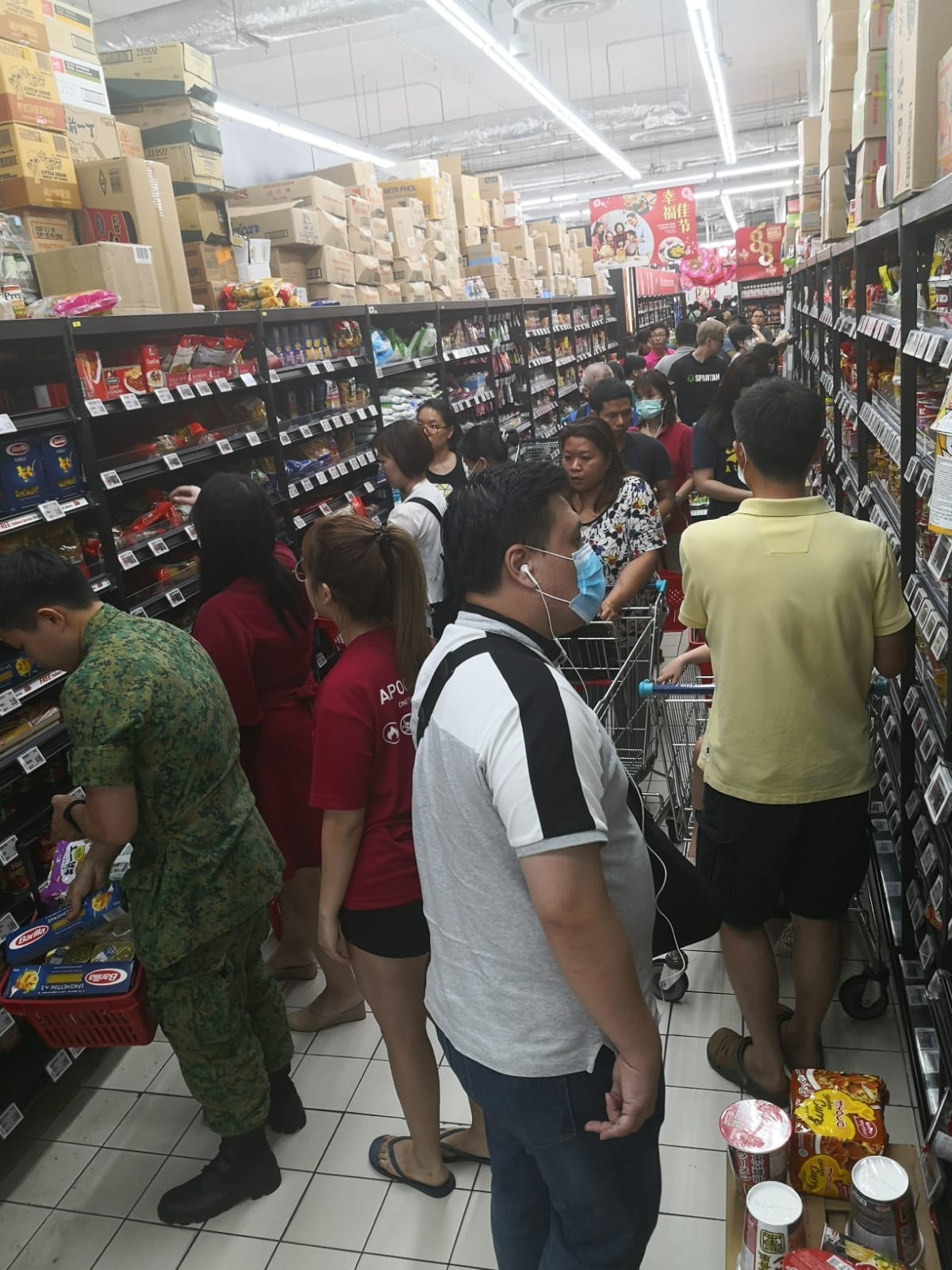 Immediately following the upgrading of our risk assessment to Orange, a wave of panic buying struck Singapore. Image via Tony Tan/Facebook.
Immediately following the upgrading of our risk assessment to Orange, a wave of panic buying struck Singapore. Image via Tony Tan/Facebook.
And as the number of infections continued on the uptick, the Ministry of Health put out more advisories to deal with the evolving situation.
Event organisers were advised to cancel or defer large scale events.
Public Health Preparedness Clinics were activated to provide subsidised treatment for respiratory illnesses and more importantly, provide 5-day MCs so that sick people would stay at home.
Churches — places where large groups of congregants gather — were advised to put in place precautionary measures such as temperature screening, reducing mingling, and suspending non-essential programmes.
March 10: The first mention of a "circuit breaker"
On Mar. 10, following the emergence of the SAFRA Jurong cluster, the government moved to suspend all activities for senior citizens, pointing out how the actions of a few "socially irresponsible" individuals led to mass infection.
In particular, one of the attendees of the Jurong SAFRA cluster had gone to dinner despite feeling unwell. The person subsequently tested positive for Covid-19.
MOH said that this could have possibly resulted in 18 additional cases, who were also at the dinner and later tested positive. Out of the 18, 10 carried on with their daily activities even though they were unwell, resulting in another 17 cases who were not even present at the dinner in the first place.
 According to MOH, the cluster at SAFRA Jurong could have been caused by one attendee who went for dinner despite feeling unwell. Via SAFRA.
According to MOH, the cluster at SAFRA Jurong could have been caused by one attendee who went for dinner despite feeling unwell. Via SAFRA.
Speaking at a press conference on the same day, Wong said suspending senior citizen activities was not the only measure the government was looking at:
"Going forward, we will look at a fuller range of social distancing measures we can put in place for public events, community activities, school closures, workplace social distancing including things like staggered hours, telecommuting as well as religious services too. We will cover a broad spectrum and we will see what we should put in place."
These have to be implemented bit by bit to avoid grinding the city to a halt, he said.
"So getting the measures right, and applying them at the right time, is critical. In that context, it is useful to think of this broad sweep of social distancing measures as something we can apply from time to time, as circuit breakers throughout the entire epidemic cycle."
March 12: PM Lee says we are “most definitely not locking down the country"
On Mar. 12, PM Lee, in his second broadcast to the nation, assured Singaporeans that the situation was under control, we were not moving to DORSON Red, and we were “most definitely not locking down the country”.
However, he cautioned that we would need additional "social distancing measures" like suspending school, staggering work hours, or compulsory telecommuting if we were to see a spike in confirmed cases.
These, he said, will act as extra "brakes", complementing our medical plans to slow down the transmission of the virus.
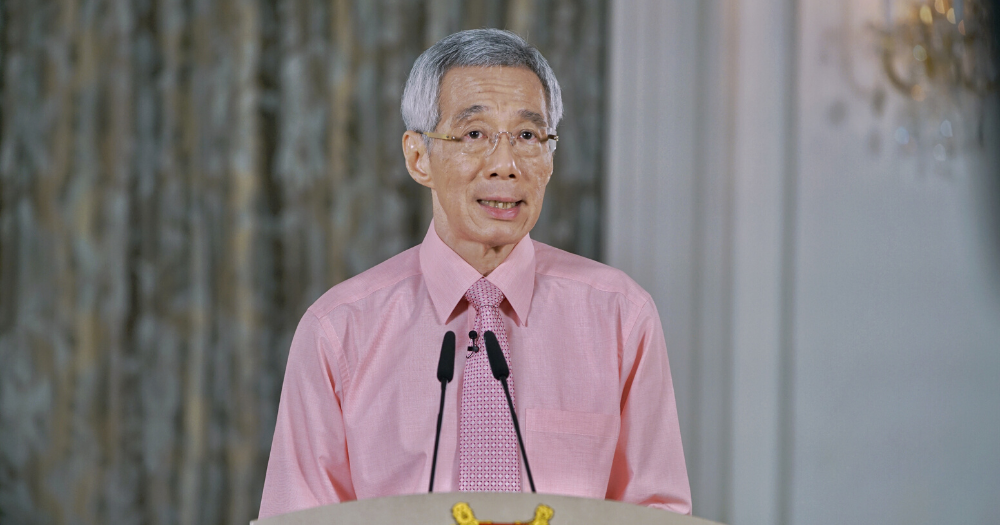 "We are not going to DORSCON Red. We are not locking down our city like the Chinese, South Koreans or Italians have done," said PM Lee. Via MCI.
"We are not going to DORSCON Red. We are not locking down our city like the Chinese, South Koreans or Italians have done," said PM Lee. Via MCI.
And sure enough, the next day saw MOH announcing that all events with more than 250 participants now must be cancelled or deferred.
Firms were, at this point, still encouraged to implement telecommuting or video-conferencing where possible. These measures were meant to "limit large crowds gathering in close proximity over a prolonged duration", said MOH.
March 20: imported cases on the rise
By Mar. 20, Singapore was reporting between 30 to 40 new cases each day — many of whom were imported, from Singapore citizens, PRs and Long Term Pass holders returning from other countries.
Safe distancing measures started to tighten.
Instead of advising deferment of non-essential travel, the government now advised the deferment of ALL travel, and if anyone should insist on doing so anyway, they would be slapped with two-week Stay-Home Notices.
Companies were now "strongly advised" to start implementing telecommuting and video-conferencing where possible, instructed MOH. Work events had to be either deferred or scaled down.
Retail and food outlets were now required to ensure that shoppers and diners were kept at least one metre apart from each other and spaced out.
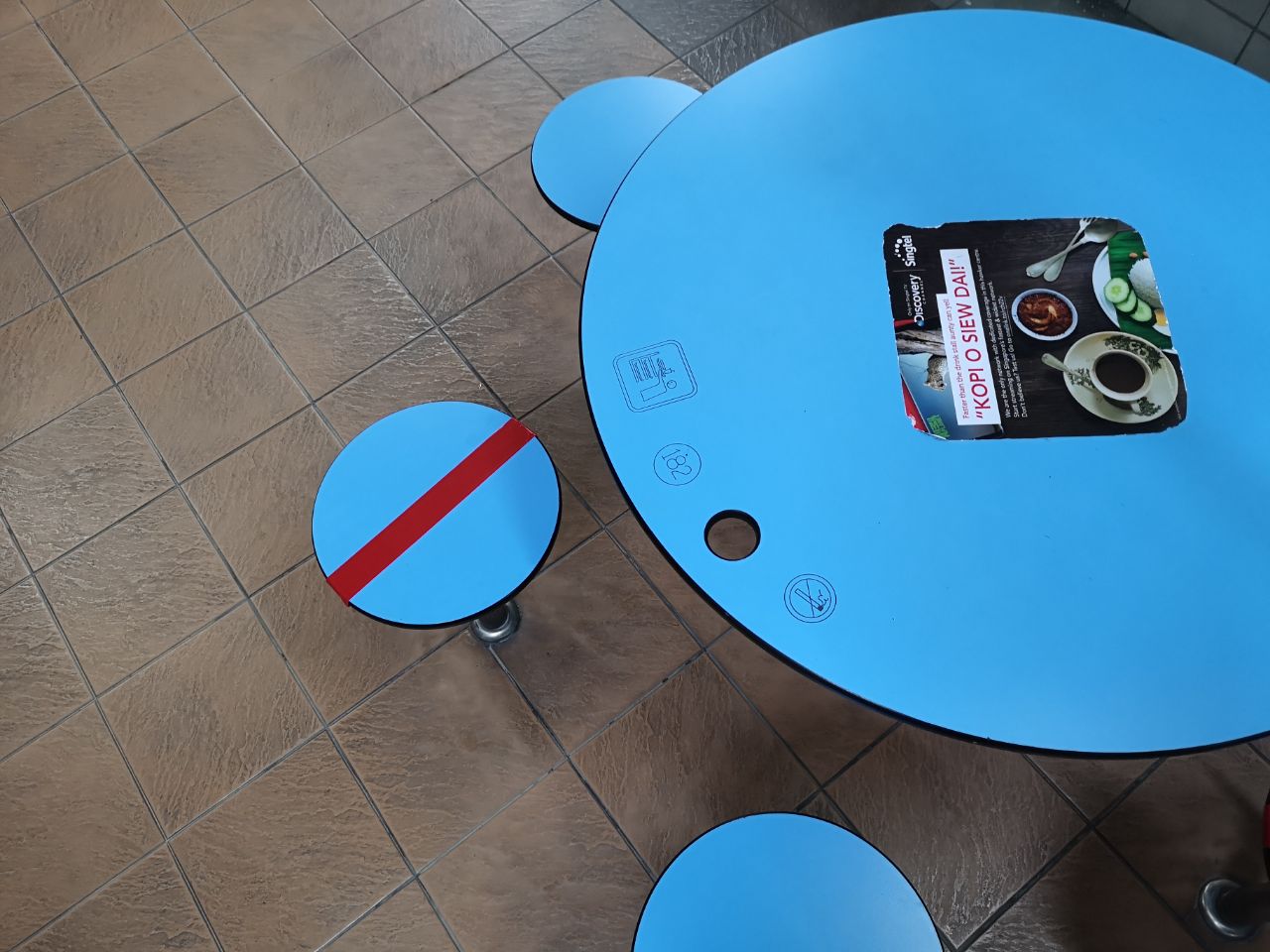 Hawker centres and other F&B outlets implemented safe distancing measures like this to keep customers spaced out. Image by Joshua Lee.
Hawker centres and other F&B outlets implemented safe distancing measures like this to keep customers spaced out. Image by Joshua Lee.
March 21: First two Covid-19 deaths
The next day, on Mar. 21, Singapore reported its first two Covid-19 fatalities.
"I know Singaporeans will be worried and anxious," said Health Minister Gan Kim Yong.
"We must take courage and not give in to our fears. We have announced a series of safe distancing measures yesterday and we must all take the necessary precautious to keep ourselves and our families safe."
On the same day, the Ministry of Manpower (MOM) advised foreign domestic workers to spend their rest days at home.
Should they wish to spend their rest day outside, the ministry advised them to avoid gathering at places such as Lucky Plaza, City Plaza, and Peninsula Plaza.
The number of reported cases continued to spike.
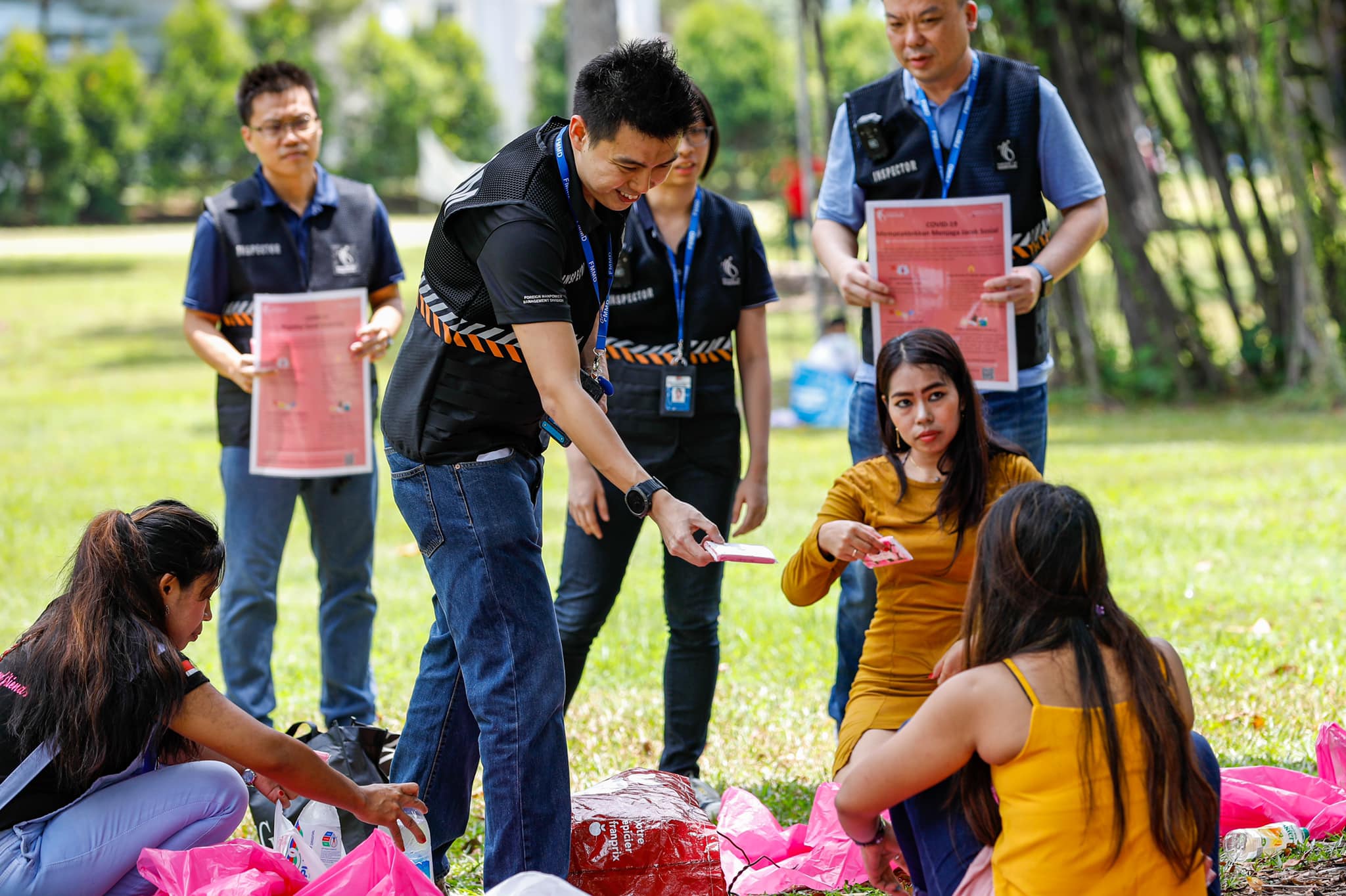 Before the "Circuit Breaker" kicked in, Ministry of Manpower officers had been going out to engage foreign workers (FWs) and foreign domestic workers (FDWs) on why they should stay home on their rest days as much as possible and avoid congregating. Via MOM/Facebook.
Before the "Circuit Breaker" kicked in, Ministry of Manpower officers had been going out to engage foreign workers (FWs) and foreign domestic workers (FDWs) on why they should stay home on their rest days as much as possible and avoid congregating. Via MOM/Facebook.
March 24: Shutting down entertainment venues, nightspots & restricting any and all gatherings to 10
On Mar. 24, MOH took its most decisive step ever: closing all entertainment venues and tuition centres, and suspending all religious activities and other large scale events.
Gatherings, including weddings and funerals, had to be kept to less than 10 people, and firms were now required by law to implement telecommuting where it was possible.
Residents and long-term pass holders who insist on travelling were told that they would have to foot their own hospitalisation bills if they come down with Covid-19.
"We must implement tighter safe distancing measures now to minimise activities and exposure, so as to significantly reduce the risks of seeding new local clusters," said MOH.
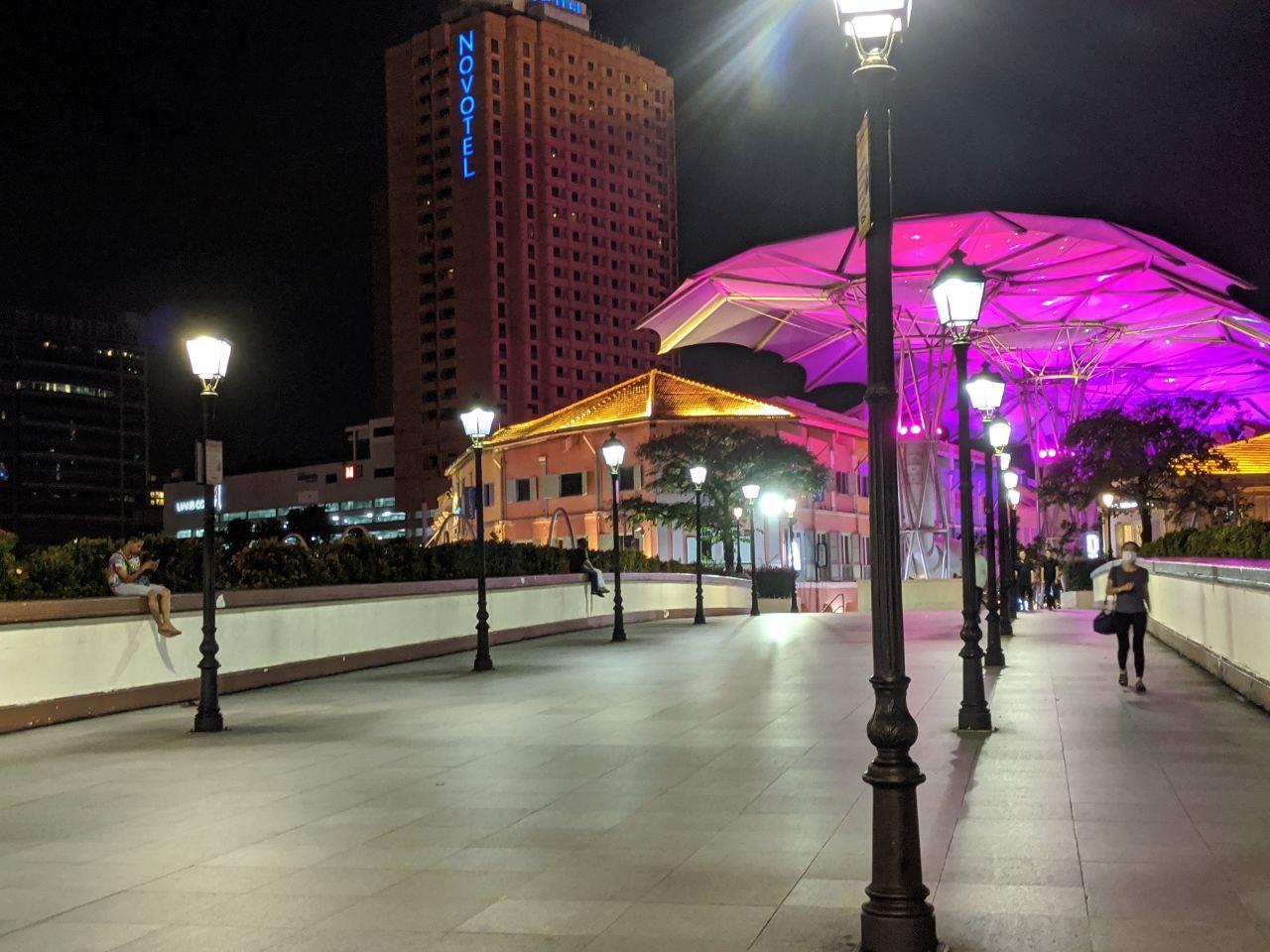 This image was taken on the first Friday after the government announced the shutting down of entertainment venues. Read Bridge was uncharacteristically devoid of people. Via Tanya Ong.
This image was taken on the first Friday after the government announced the shutting down of entertainment venues. Read Bridge was uncharacteristically devoid of people. Via Tanya Ong.
In a press release, the ministry warned Singaporeans to take the safe distancing measures seriously or more drastic measures would be needed later.
"Stay at home as much as you can, and go out if you need to work, go to school, go out for essential tasks – but otherwise stay at home, reduce your social gatherings and all other activities for the next one month," said Wong as he pleaded for Singaporeans to cooperate in reducing the transmission of the virus.
March 31: Local transmission on the significant rise
By Mar. 31, Singapore received good and bad news: The number of returnee cases was tapering off, but there were more unlinked local cases popping up.
And then...
April 3: The Circuit Breaker lands — a.k.a. where we now find ourselves.
Friday, April 3, saw PM Lee returning to address the nation once more — in his pink shirt, scarlet tie and armed with his nifty language-changing blue cup.
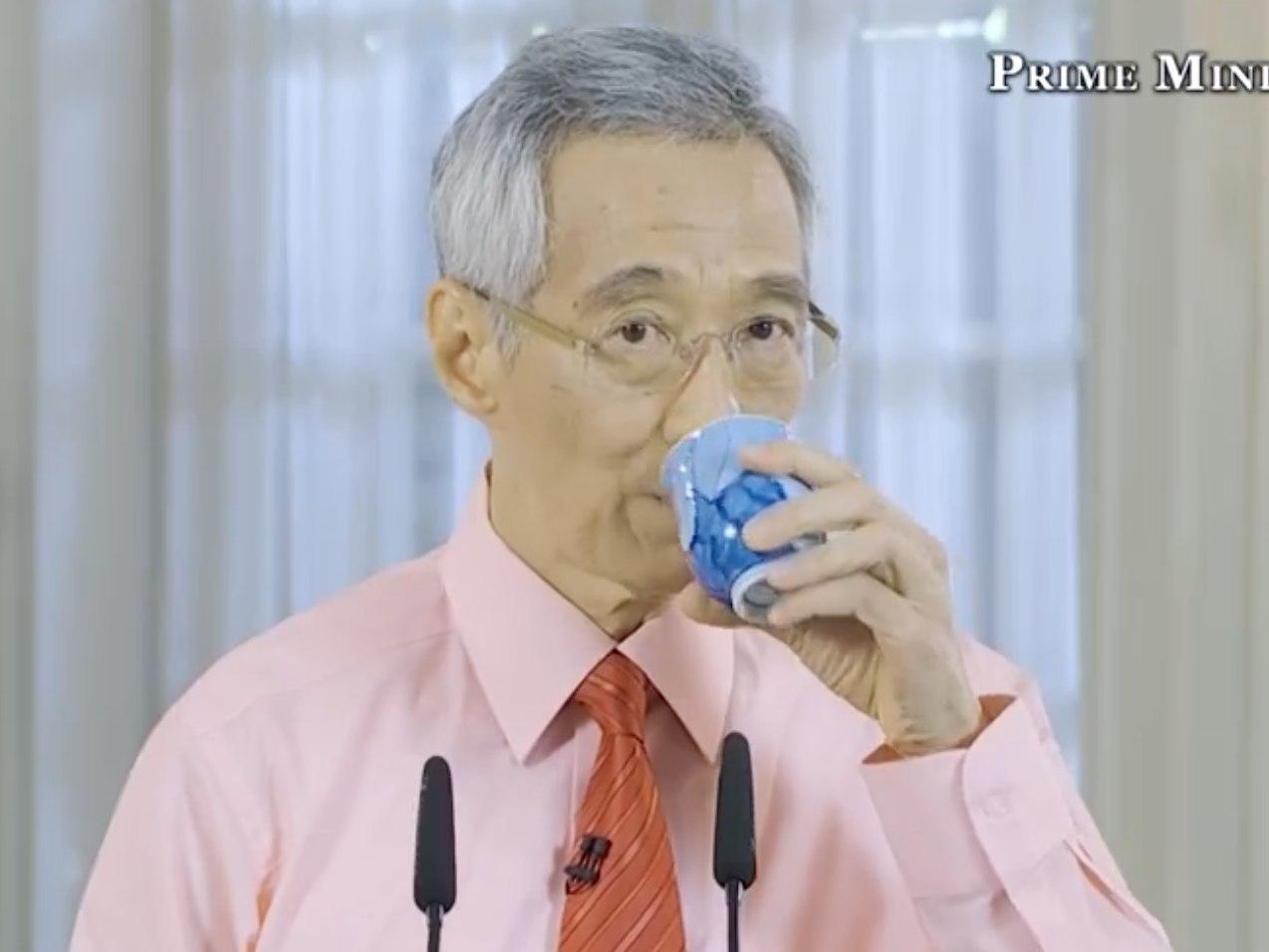
It was here he would announce a "circuit breaker" to "pre-empt the trend of increasing local transmission of Covid-19" after it was clear the numbers of local and unlinked cases were rising way too fast.
Non-essential businesses that could not be carried out by telecommuting had to shut down. This, of course, meant plenty of shops.
All hawker centres, cafes and restaurants were ordered to close their seating areas and are now only allowed to do takeaway or delivery.
Schools shifted to full-time Home-Based Learning, after just a week of trying it out. Recreational venues and places of worship were completely closed.
Members of the public are now required by law to stay home and avoid going out except for essential services and to procure daily necessities.
Gatherings were disallowed (the previous rule of "not more than 10 people per group" was scraped). While restaurants and hawkers were allowed to continue operating, dining in was prohibited.
"The rules are simple, and we hope everyone takes this seriously: stay at home," said Wong.
It is simple, but incredibly onerous. You can't actually eat in public and with the recently-passed Covid-19 (Temporary Measures) Act, gatherings in public and private will actually be a crime.
Circuit Breaker ≠ Lockdown
So here we are with what looks like, but still isn’t, a lockdown. Our lives are majorly disrupted (closure of schools, work from home orders) and we're required by law to practise social distancing — all indicators of DORSCON Red.
Yet, we aren’t calling this a lockdown — nor are we in DORSCON Red.
DORSCON, said MOH's director of medical services Kenneth Mak on Apr. 3, is a risk assessment of the local situation.
"We look at the degree of community spread in the country, and we also look at our ability to control that spread within the community itself."
While there is an increase of community spread as opposed to one month ago, this is still a situation that is still controllable, he said. Hence, there are no plans to move to DORSCON Red.
This is not a lockdown, said Wong who prefers to call it a "significant tightening of measures" that are implemented in increments.
"With these measures, we are not stopping all work, we're not shutting down the economy. Essential businesses will continue. We are not stopping people from going out if they really need to."
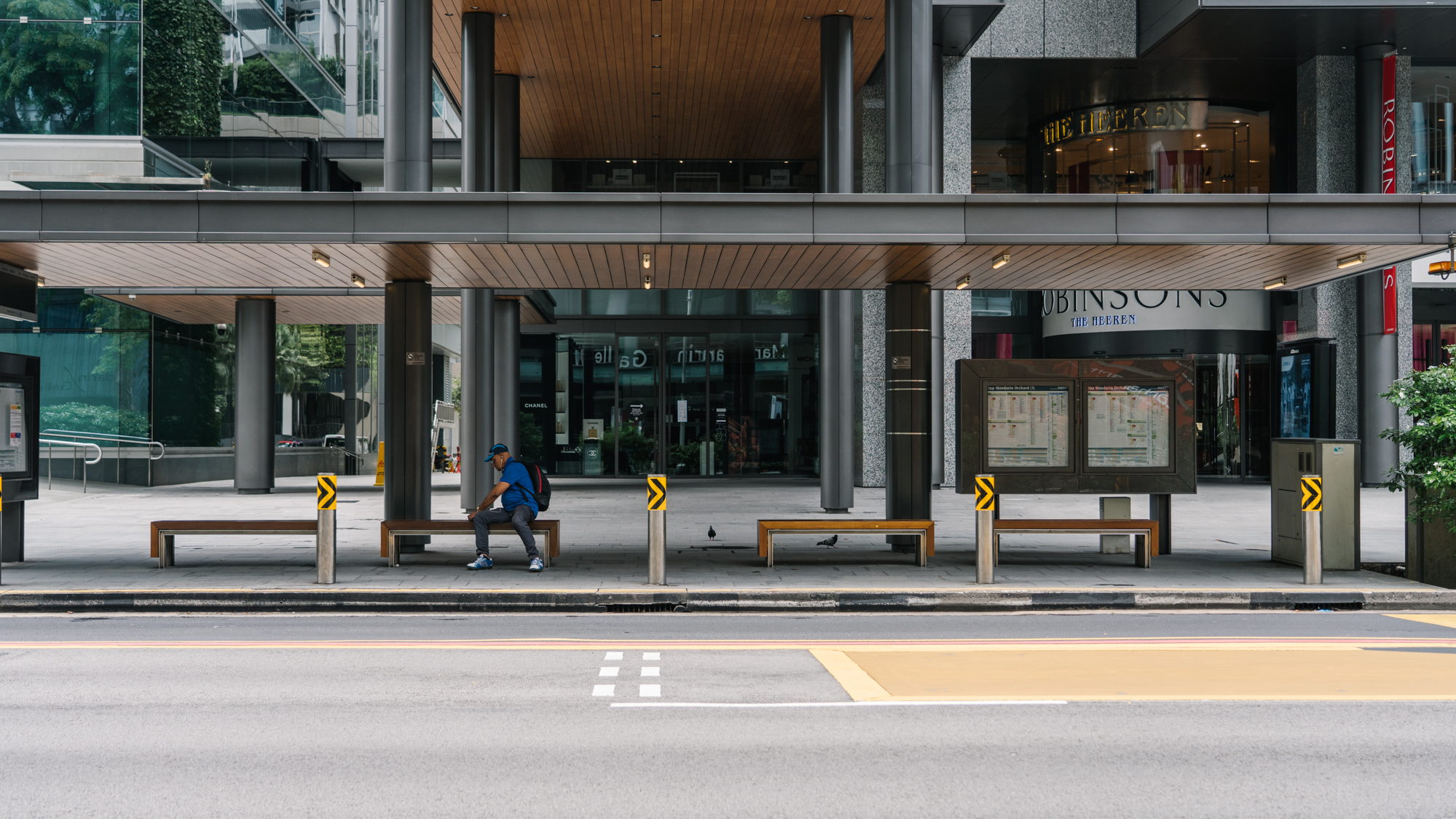 An empty bus stop along Orchard Road, Singapore's shopping belt, on the first day of "Circuit Breaker". Image by Andrew Koay. More photos here.
An empty bus stop along Orchard Road, Singapore's shopping belt, on the first day of "Circuit Breaker". Image by Andrew Koay. More photos here.
True lockdowns in other places, like Wuhan and Italy for instance, look quite different.
In Italy, which is still under lockdown, people can be questioned by the authorities if they're seen travelling outside. Public gatherings and activities are prohibited and citizens are subjected to a 6pm curfew.
The lockdown in Wuhan, which was recently lifted, was even more onerous. Private vehicles could not travel on the road without permission and families could only send one member out every two days for necessities. Officials also went door to door to conduct health checks.
Foreign worker dorms: A sign of things to come?
Now, of course, it will take a couple of weeks (or more) of Circuit Breaker — hence its duration ending May 4 — to see any significant result, but in the immediate meantime, the number of cases has continued on a very high upswing.
On Apr. 5, the number of new reported cases started to exceed 100.
Hotspots were also identified in foreign worker dormitories, more and more of which are quickly emerging as large clusters of infections. In fact, more than 200 of Singapore’s highest-ever number of cases in a day (287) reported just on Thursday night (Apr. 10) came from foreign worker dormitories.
To date, five dormitories have been effectively locked down (but of course, we're not calling it that. They're gazetted as Isolation Facilities).
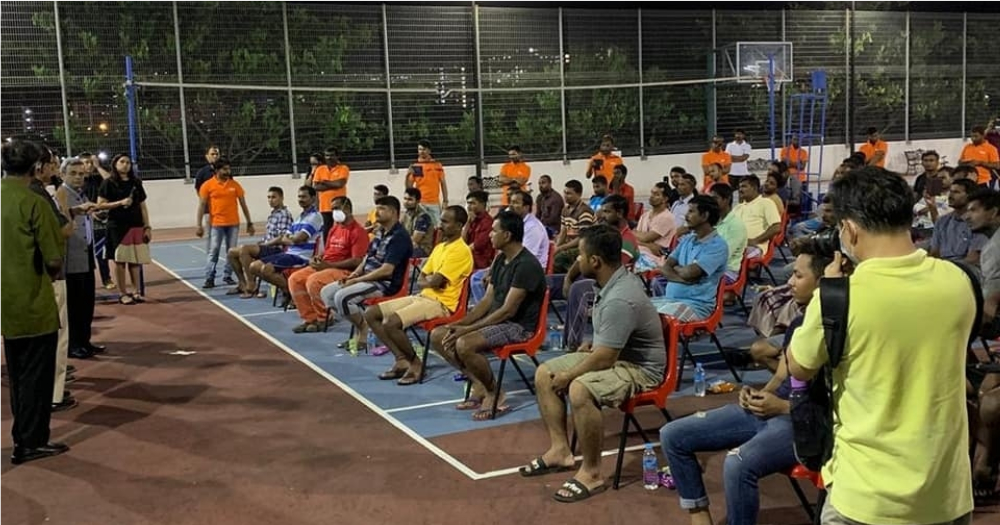 Migrant workers at Westlite Papan Dormitory were addressed by the High Commissioner of India in Singapore after the dormitory was gazetted as an isolation facility. Image via High Commission of India in Singapore/ Facebook.
Migrant workers at Westlite Papan Dormitory were addressed by the High Commissioner of India in Singapore after the dormitory was gazetted as an isolation facility. Image via High Commission of India in Singapore/ Facebook.
Apart from not being allowed to leave their campuses at all, foreign workers in these dormitories are prohibited from moving between blocks. They were also advised to cease interactions with others who do not reside in the same room or floor.
It is a truly frightening picture of what a true lockdown is and while the general population might not be subjected to such a measure just yet, Wong warned on Apr. 9 that more movement restrictions are in the pipeline if Singaporeans still insist on not staying put at home.
Like little frogs in a slowly-boiling pot, we have gotten to this "circuit breaker" through small incremental steps. Who knows what the next could be?
Perhaps we really should all make the effort to coop ourselves at home and endure the cabin fever, if we want to avoid a true lockdown in the near future.
Mothership Explains is a series where we dig deep into the important, interesting, and confusing going-ons in our world and try to, well, explain them.
This series aims to provide in-depth, easy-to-understand explanations to keep our readers up to date on not just what is going on in the world, but also the "why's".
Top images by Joshua Lee, Andrew Koay.
If you like what you read, follow us on Facebook, Instagram, Twitter and Telegram to get the latest updates.
